Sunday, May 2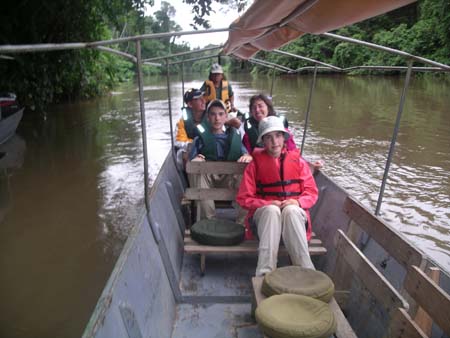
Paula and Steve: We awoke at the crack of dawn to greet
the beautiful birds of the Amazon as part of a 6:30AM boating expedition.
From our canoe, we were able to see many varieties of birds including parakeets,
parrots, egrets, heron, falcons and vultures. Bird watching in the Amazon
has been best when we're near water, either the lagoon by  our
cabana or the river. Here we are always rewarded with the beautiful sounds
or sightings of the wonderful variety of birds that live in the Amazon Rainforest.
our
cabana or the river. Here we are always rewarded with the beautiful sounds
or sightings of the wonderful variety of birds that live in the Amazon Rainforest.
The highlight of today's bird watching was a trip to a "macaw lick."
This is a clay riverbank that contains minerals that the birds crave in their
diet, and is an easy way to observe large groups of macaws and other colorful
sp ecies.
As we approached the lick, we first heard and then saw a group of 7-8 scarlet-crested
macaws fly overhead and land in a magnificent fichus tree. We observed them
closely before they were joined by several yellow-crowned amazons. Other macaws
soon joined in, and we were treated to a colorful and noisy show from these
unique birds. Unfortunately, the clay lick was wet from some early morning
showers, and this prevented the birds from actually landing on the riverbank.
When the clay lick is wet, it's hard for the birds to extract the minerals
and they often choose not to risk becoming prey at the hands of a hiding jaguar
or ocelot. However, it was still great to see the groups of these birds up
in the trees. Eventually, we headed back to the lodge hungry for breakfast.
ecies.
As we approached the lick, we first heard and then saw a group of 7-8 scarlet-crested
macaws fly overhead and land in a magnificent fichus tree. We observed them
closely before they were joined by several yellow-crowned amazons. Other macaws
soon joined in, and we were treated to a colorful and noisy show from these
unique birds. Unfortunately, the clay lick was wet from some early morning
showers, and this prevented the birds from actually landing on the riverbank.
When the clay lick is wet, it's hard for the birds to extract the minerals
and they often choose not to risk becoming prey at the hands of a hiding jaguar
or ocelot. However, it was still great to see the groups of these birds up
in the trees. Eventually, we headed back to the lodge hungry for breakfast.
 The
schedule for the rest of the day was exciting. Alex had planned a hike for
us that included a "surprise" in the morning, lunch in the jungle,
a visit to a local Achuar community in the afternoon, fishing in the evening
and then a night boat ride for in search of caimans!
The
schedule for the rest of the day was exciting. Alex had planned a hike for
us that included a "surprise" in the morning, lunch in the jungle,
a visit to a local Achuar community in the afternoon, fishing in the evening
and then a night boat ride for in search of caimans!
We traveled on the river for a good 40 minutes before reaching the start
of the trail, and our group of eight disembarked on the muddy shoreline. Alex
had told us that the trail today was a new one that he had just recently  helped
clear, and he seemed excited to share it with us. Yaguar, our native Achuar
guide, led the way with using his machete to clear our path. After tramping
through dense vegetation for 10-15 minutes, we asked Alex if he was capable
of leading us out of the jungle without Yaguar - he just laughed. We enjoyed
the combination of these two guides - Yaguar was born and raised here and
is able to give us an authentic feel for the Amazon while Alex, a mestizo
(part Indian, part Spanish) from Quito, is also ex
helped
clear, and he seemed excited to share it with us. Yaguar, our native Achuar
guide, led the way with using his machete to clear our path. After tramping
through dense vegetation for 10-15 minutes, we asked Alex if he was capable
of leading us out of the jungle without Yaguar - he just laughed. We enjoyed
the combination of these two guides - Yaguar was born and raised here and
is able to give us an authentic feel for the Amazon while Alex, a mestizo
(part Indian, part Spanish) from Quito, is also ex tremely
knowledgeable about the local habitat and also acts as a translator for Yaguar.
tremely
knowledgeable about the local habitat and also acts as a translator for Yaguar.
One of the highlights of our hike was a fantastic swampy lake that we explored
and crossed. This area was absolutely teeming with wildlife, included a huge
number of very noisy birds, a small caiman and turtles. We were walking in
very deep mud that often rose to the top of our boots, and we were warned
 repeatedly to watch our step (to avoid sinking any deeper). We approached
quietly to avoid scaring any of the wildlife away, but soon found ourselves
the center of attraction for several colorful birds that flew repeatedly in
front of us, apparently in an effort to distract us away from their nests.
repeatedly to watch our step (to avoid sinking any deeper). We approached
quietly to avoid scaring any of the wildlife away, but soon found ourselves
the center of attraction for several colorful birds that flew repeatedly in
front of us, apparently in an effort to distract us away from their nests.
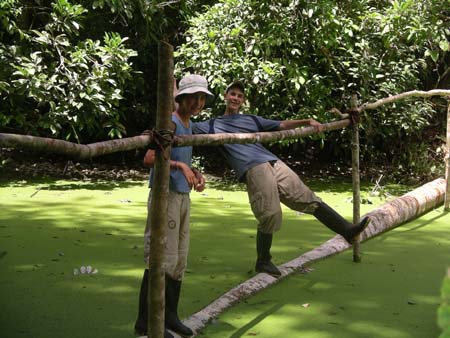 We
eventually worked our way around the edges of the lake until we reached a
bridge that had recently been constructed and led back to the trail. The bridge
looked unstable at best, and David insisted on making us all nervous with
some of his usual antics while crossing. Fortunately, everyone made it across
safely.
We
eventually worked our way around the edges of the lake until we reached a
bridge that had recently been constructed and led back to the trail. The bridge
looked unstable at best, and David insisted on making us all nervous with
some of his usual antics while crossing. Fortunately, everyone made it across
safely.
As we hiked, Alex and Yaguar continued to teach us about the various plants
and insects of the Amazon. We learned how the local people use the palm trees
for food and to make blow guns for hunting. We saw how the lemon ant tree
lives 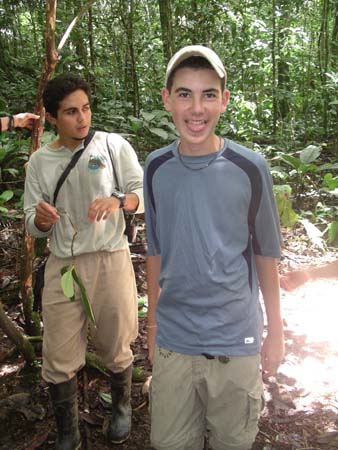 harmoniously
with the ants that live in its branches and produce formic acid. Alex actually
cut off part of this tree to show us how the ants live inside the hollow branches
and then before we knew it he popped the ants from a branch inside his mouth.
"Wow, these taste good," he commented in a matter-of-fact tone.
Alex then encouraged us all to give them a try, and after some initial (and
justifiable) trepidation, we all popped several of the lemony creatures in
our mouths. While we don't plan on making ants part of our diets at home,
it certainly was another unique experience for us to add to our list! We even
ate them without any chocolate covering…
harmoniously
with the ants that live in its branches and produce formic acid. Alex actually
cut off part of this tree to show us how the ants live inside the hollow branches
and then before we knew it he popped the ants from a branch inside his mouth.
"Wow, these taste good," he commented in a matter-of-fact tone.
Alex then encouraged us all to give them a try, and after some initial (and
justifiable) trepidation, we all popped several of the lemony creatures in
our mouths. While we don't plan on making ants part of our diets at home,
it certainly was another unique experience for us to add to our list! We even
ate them without any chocolate covering…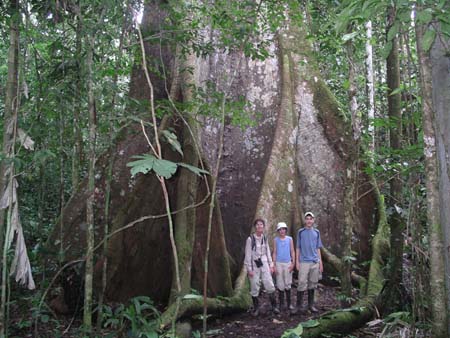
The surprise that Alex had told us about ended up being a huge ceibo tree
that is over 300 years old. This is absolutely the biggest tree that any of
us had ever seen, and it is truly amazing. It is supported by a set of huge
buttresses that are used to support its massive  trunk.
Alex told us that although this is a large specimen, there are actually trees
bigger than this elsewhere in the forest. This was hard for us to believe…
trunk.
Alex told us that although this is a large specimen, there are actually trees
bigger than this elsewhere in the forest. This was hard for us to believe…
After about 2 ½ hours of wonderful hiking, we reached the end of the trail and were thrilled to find a fantastic hot lunch waiting for us. We couldn't help but all feel quite spoiled, especially thinking about how much work it must have been for the staff to transport and set up this meal for us right in the middle of the rainforest. However, no one complained…
Next was a trip to one of the local Achuar communities that appear all along the rivers. We visited a man who is actually the "shaman" for his community - this means that he's the spiritual and medical doctor for the group of 150 natives who live here. His home is built in traditional Achuar style, totally open and without walls. After we arrived, we all sat and went through a formal introduction process. The man's wife then served us a local brew called "chicha." We had been warned in advance that it would be considered insulting if we did not at least all hold the bowls and pretend to drink the concoction. Apparently, it's made from a leaf that is chewed by the women and then left to ferment. This didn't sound too appetizing, but we at least arrived with an open mind. However, when we saw the man's wife repeatedly use her hands to wipe her nose and mouth, and then immediately run her fingers through the bowls to squeeze and sift the drinks being served to us, we decided to simply hold the bowls and not actually indulge…
We had an interesting dialogue with the shaman, and received some unexpected answers to questions. When Steve asked him what the biggest problem facing his village was, his first response was to talk about adultery. He told us that adultery is immediately punishable by the execution of both the man and woman (no trial involved), and that this is totally accepted by the Achuar people, even when direct family members are involved. He also told us about how the community uses the forest to support almost all of their needs, including providing food, medicine and building materials.
The role of males and females were very clear today. For example, the area of the home that we were sitting in was clearly the "male area", and women are allowed in only with explicit permission. The shaman's home is built in traditional Achuar style, with a roof but no walls - it's totally open. Unfortunately, we weren't allowed to take any pictures of our visit today, so we don't have any photographs showing the people or their houses.
 As
we started our trip back on the river, Alex spotted a lone figure upstream
on a small raft. We drove our boat closer, and Yaguar recognized the man as
an Achuar from a local community who was traveling to Kapawi for work. We
subsequently learned that this trip takes him close to 10 hours, and were
amazed as we got closer to see how hard he was working with a long pole to
push himself along. The raft itself was extremely small, made of four logs
that had been tied together. Yaguar called out to the man offering him a ride
back to Kapawi, and before we knew it the man had jumped on our boat, simply
leaving his raft afloat in the river. Initially, we couldn't understand how
he could just leave the raft, but Alex explained that this would save the
man another four hours of difficult travel and that the rafts are very easy
for the Achuar to make.
As
we started our trip back on the river, Alex spotted a lone figure upstream
on a small raft. We drove our boat closer, and Yaguar recognized the man as
an Achuar from a local community who was traveling to Kapawi for work. We
subsequently learned that this trip takes him close to 10 hours, and were
amazed as we got closer to see how hard he was working with a long pole to
push himself along. The raft itself was extremely small, made of four logs
that had been tied together. Yaguar called out to the man offering him a ride
back to Kapawi, and before we knew it the man had jumped on our boat, simply
leaving his raft afloat in the river. Initially, we couldn't understand how
he could just leave the raft, but Alex explained that this would save the
man another four hours of difficult travel and that the rafts are very easy
for the Achuar to make.
After arriving back at Kapawi, we quickly dropped lines in the water to take
another shot at fishing. Katie caught a small catfish, but we were all somewhat
dismayed to find that the Kapawi kitchen staff had pulled in five nice fish
right out their back door while we had been unproductively fishing down at
the  river.
We rushed up to try ourselves, but they had apparently caught everything already…
It was still all great fun.
river.
We rushed up to try ourselves, but they had apparently caught everything already…
It was still all great fun.
After dinner we took a boat ride on the river to search for caiman and to also get more of a sense for the rainforest after dark. The river was very high tonight, making it very difficult to spot any caimans. However, the full moon and cool air made for a very relaxing and enjoyable trip.
Tonight we were treated to a traditional Achuar dinner as part of our farewell from Kapawi. It was a very special occasion, and we enjoyed our last meal here. It's also been great to get to know some of the guests who we spent time with here, and plan to keep in touch with them in the future.
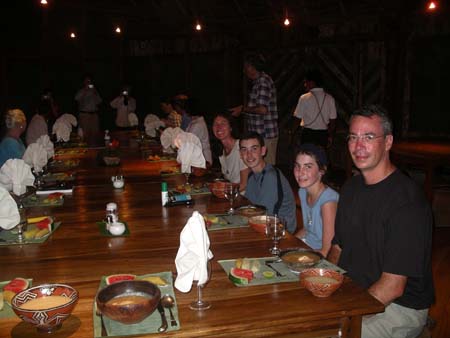
Tomorrow morning we leave Kapawi. We will fly back to Quito and then to Lima to begin our stay in Peru.
